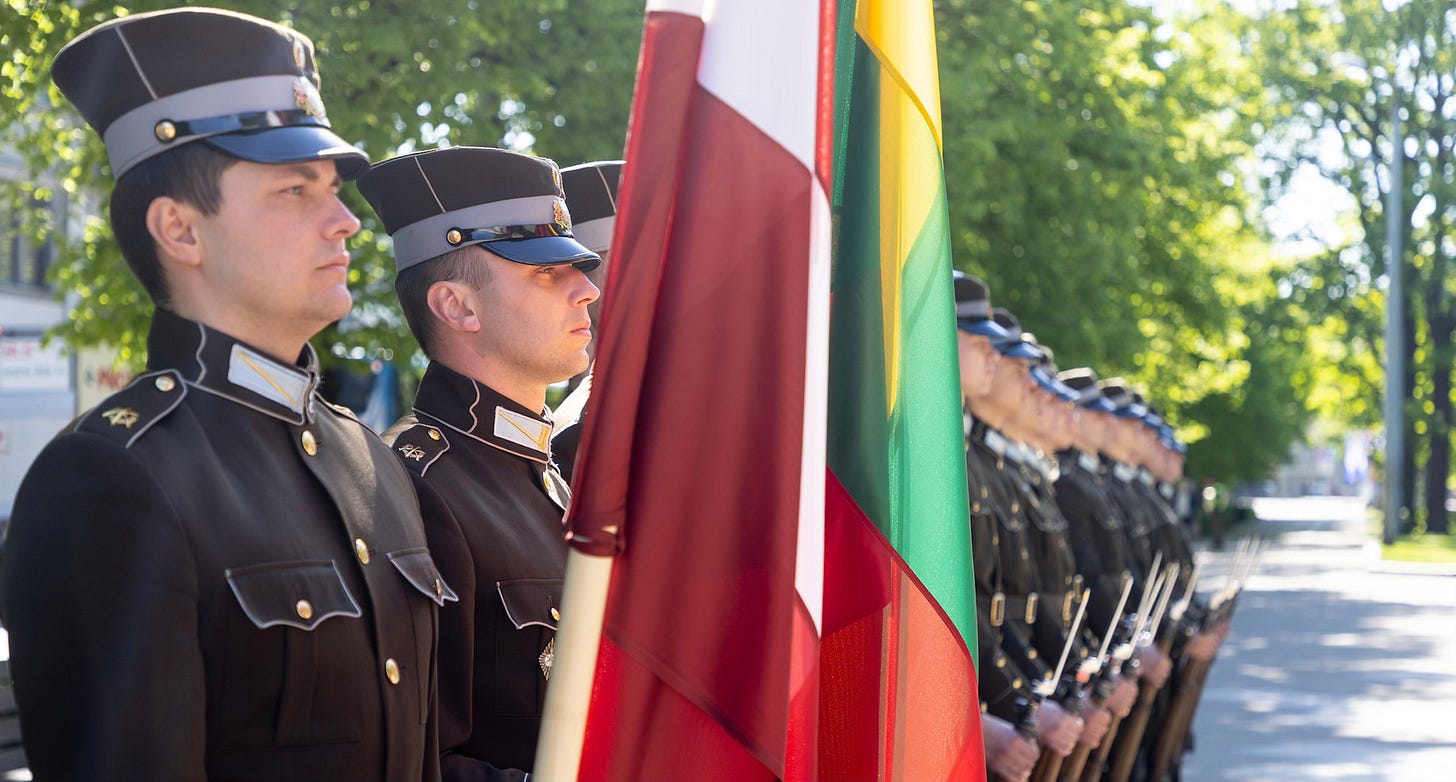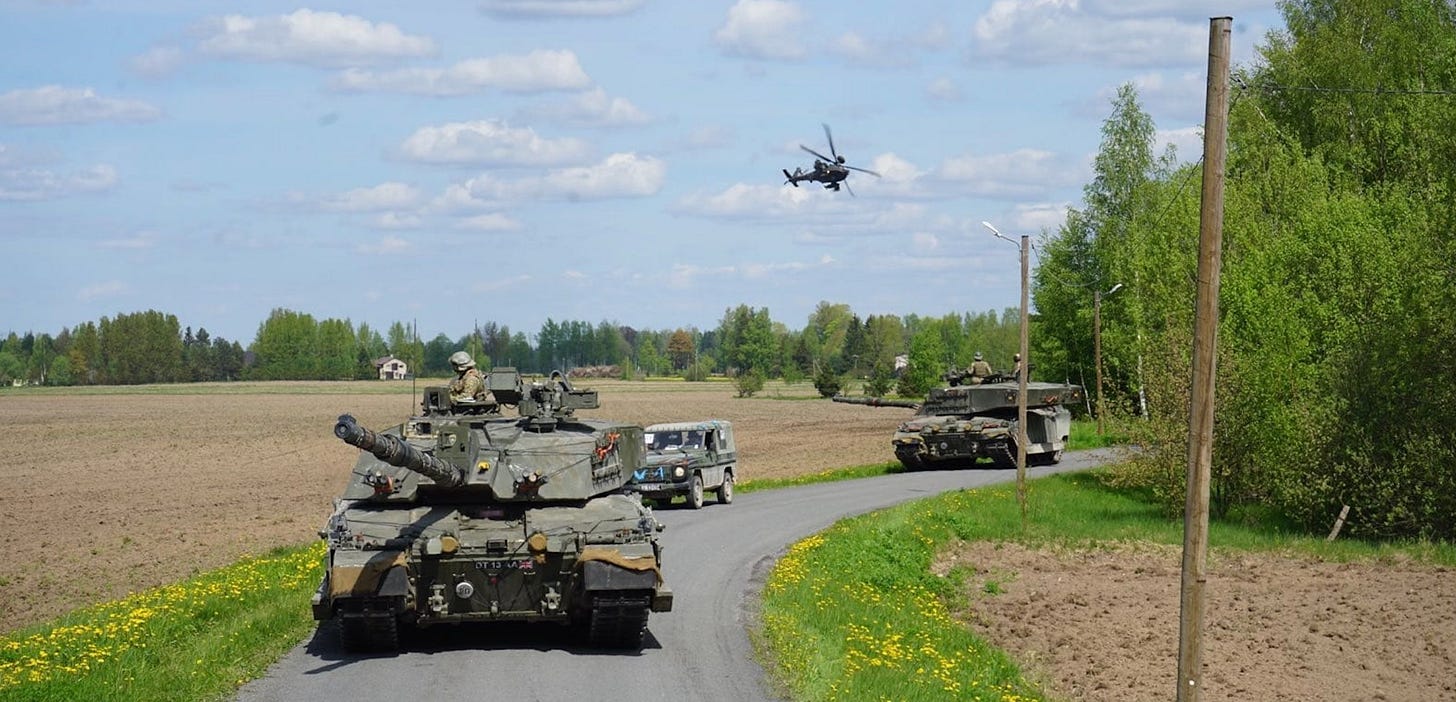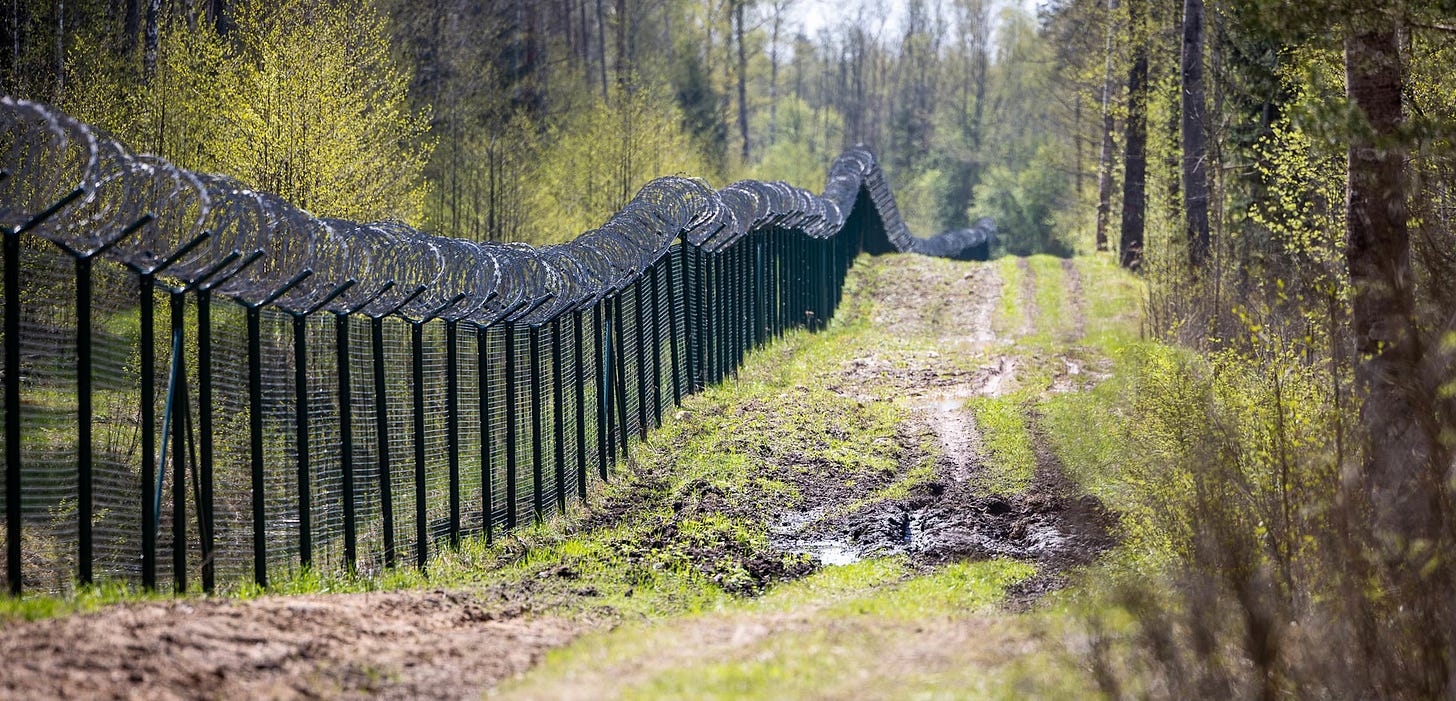The Baltic (R)evolution in Military Affairs
By Dr. Justina Budginaite-Froehly - A role model for Europe's new strategic posture.
During the past 20 years of their NATO membership, the Baltic states achieved a multi-faceted transformation in their strategic posture establishment, military capability development, and level of interdependence with their NATO allies. Once inexperienced newcomers, the so-called “one-issue” countries (referring to their focus on Russia as a strategic challenger to NATO) with no clear role in the alliance and doomed to have an “indefensible” territory, Lithuania, Latvia, and Estonia have gradually turned into an exemplary NATO region demonstrating a deep understanding of regional security issues and making practical steps towards better preparedness, including proving their defensibility in practice. The Baltic states made substantial progress in cyber and energy security, strategic communication, defense spending, and military capability development. These achievements in the Baltic states’ military affairs serve as an example for other NATO member states often lacking the ambition to do and spend more on their security and defense. They demonstrate how to turn vulnerabilities and limited resources into chances and innovative solutions.
Reconnecting with the West
Immediately after regaining their independence in the 1990s, the Baltic states initiated the restoration of their armed forces. Though they did not start completely from scratch, given their statehood and military tradition during the interwar period (1918-1940) and their experience in irregular armed resistance during the Soviet occupation, the Baltic states were confronted with multiple constraints in the effort of (re-)building their national militaries. A Russian energy blockade, massive financial issues, and remaining Russian armed forces on the Baltic states’ territories until mid-1993 (Lithuania) and mid-1994 (Latvia and Estonia) were limiting conditions for rapid progress in the restoration and modernization of the armed forces. However, with the aspired accession to NATO representing the sole viable option for guaranteeing their future security, the Baltic states were highly motivated to move forward with reform implementation in order to exploit the window of opportunity for joining the alliance as soon as possible. Ten years later, in 2004, the Baltic states became full-fledged members of NATO. It represented a remarkable achievement for countries that spent 50 years as integral parts of the Soviet Union and were exposed to systematic attempts to destroy all forms of their independent societal structures including (and especially) the military ones.
As newcomers to the alliance, Lithuania, Latvia, and Estonia were confronted with an international security agenda that was rather distant from their national agendas. NATO’s focus on counterterrorism and efforts in strengthening its expeditionary profile to perform crisis management operations outside its geographic area represented a major challenge for the Baltic states in finding their role in the alliance. However, determined to strengthen their standing among the allies (especially the US as the most crucial partner), the Baltic states made steps to adjust to the prevailing Zeitgeist. They joined NATO’s International Security Assistance Force (ISAF) in Afghanistan in 2005, intending to support the alliance in its counterterrorism operation through engagement in civilian and military tasks. Estonia became involved in military operations in the Helmand province, Latvia coordinated NATO’s military supply chains through the Riga seaport, and Lithuania took over the leadership of the provincial reconstruction team (PRT) in Ghor province. In addition to that, the special forces units of the Baltic states were active in multiple locations in Afghanistan supporting the allies in various active combat operations. The mission in Afghanistan (although in itself fundamentally unsuccessful as the chaotic withdrawal in 2021 and the events in the aftermath have shown) allowed the armed forces of the Baltic states to adapt to NATO structures and enhance their interoperability with the allied forces.
The Baltic armed forces were at least partially re-designed as light flexible units able to conduct irregular warfare and engage with civilian players in common crisis management operations. Lithuania and Latvia decided to move to professional military service and thus abolished conscription in 2006 (Latvia) and 2008 (Lithuania). Out of the three Baltic states, only Estonia preserved the universal conscription model. While Estonia sustained military spending close to 2% of GDP throughout the years, the defense budgets of the remaining two Baltic states were scarce during this time, especially in the case of Lithuania, which spent less than 1% of GDP for defense for several years in a row. Limited defense financing and light-handed conscription abolishment were a consequence of the prevailing dangerous overconfidence in NATO’s ability to immediately support its allies in case of a potential military crisis. At the same time, the principles of host nation support — meaning obligations to provide effective logistical assistance for incoming allied forces — were not reflected seriously in the Baltic states. Insufficient investment in the development of national defensive capabilities left the Baltic states highly vulnerable amid the existing serious limitations for military logistics in the region that could hamper accessibility to NATO’s military supplies and reinforcements. These issues are still not fully resolved.
Closing Security Gaps
As a part of NATO’s commitment to the Baltic Sea region, its peacetime instrument — the Air Policing Mission — was extended to the Baltics in 2004. With Lithuania, Latvia, and Estonia lacking their own national military capabilities in this area, NATO stepped in with rotational contingents to help protect the air space over the Baltics. The level of urgency for doing so was high — situated in an unfavorable geographic location between mainland Russia, the Kaliningrad enclave, and Belarus, the Baltic states were permanently confronted by provocative actions by Russian Force aircraft flying near the Baltic states’ airspace without using transponders, communicating with Air Traffic Control, or having filed a flight plan. The Air Policing Mission started with deploying Allied forces to the air base at Šiauliai, Lithuania. Initially designed as temporary support, the Baltic Air Policing Mission was declared permanent in 2012 after years of active advocacy of the Baltic states. After the illegal annexation of Crimea by Russia in 2014, the mission was expanded to include the deployment of Allied air forces to the air base at Ämari, Estonia. As of March 1, 2024, the Latvian military base at Lielvārde is the third NATO base to host Allied fighter detachments for conducting the Baltic Air Policing Mission. The Baltic states themselves have been actively involved in the mission through the host nation support framework, taking over the responsibility of its smooth logistical and organizational implementation.
In addition to closing security gaps in their air space protection, the Baltic states were active in advocating the broadening of NATO’s agenda to the areas of cyber, energy security, and strategic communication. The Baltic states had an early firsthand experience with hybrid security challenges. For example, Estonia faced massive cyber attacks in 2007 after a dispute with Russia regarding the relocation of a Red Army monument from Tallinn's city center, Lithuania was exposed to ongoing Russian energy blackmailing due to dependence on Russian energy supplies, and Latvia faced challenges in managing its national security in the context of its large Russian-speaking minority. Based on these thematic specialization areas, the Baltic states became host nations of NATO Centres of Excellence: Since 2008, Estonia has been leading the NATO Cooperative Cyber Defence Centre of Excellence (CCD COE), in 2012, Lithuania became the host nation of the NATO Energy Security Centre of Excellence (ENSEC COE), and since 2014, Latvia has hosted the NATO Strategic Communications Centre of Excellence (STRATCOM COE). Although the final decision to establish these centers of excellence was made collectively on the highest political level in NATO, the Baltic states were the primary initiators of the expansion of NATO’s network of excellence to cyber, energy, and strategic communication areas — all representing crucial aspects of hybrid warfare which we can now witness in Ukraine and beyond.
Improving Strategic Posture
As a consequence of the deteriorating security situation on NATO’s Eastern flank since Russia's illegal annexation of Crimea, and especially since its full-scale invasion of Ukraine in 2022, several important decisions leading to an upgrade of the strategic posture in the Baltics have been made. On the national level, Lithuania reinstated conscription in 2015, shifting its focus back to territorial defense. Latvia followed suit in 2023. Military expenditures began to rise well beyond NATO’s average. In the case of Lithuania, it rose from 0.8% of GDP in 2013 to 2.5% of GDP in 2023. Estonia’s military expenditure rose from 1.9% of GDP in 2013 to 2.7% of GDP in 2023. Latvia’s military spending grew from 0.9% of GDP in 2013 to 2.3% of GDP in 2023. On a regional basis, the Baltic states reached NATO’s benchmark of 2% of GDP military spending already in 2018, signaling their serious attitude toward burden-sharing within the alliance. Further increases are planned in all three Baltic states as they are among those advocating for an increase in NATO’s common benchmark for military spending to 2.5%-3% of GDP.
NATO’s commitment to regional security in the Baltics was equally strengthened. Following the annexation of Crimea, NATO decided to send troops to the Baltics under the Enhanced Forward Presence framework (eFP) to build up its deterrence and defense posture on the Eastern flank. Since 2017 Lithuania, Latvia, and Estonia have hosted multinational battlegroups led by framework nations — Germany in Lithuania, Canada in Latvia, and the UK in Estonia. After Russia invaded Ukraine in 2022, NATO agreed to scale up the multinational battlegroups in the Baltics from battalion to brigade size. In addition, Germany decided to permanently station an additional brigade in Lithuania — a decision made on a bilateral basis between Lithuania and Germany, thus contributing significantly to the current effort of upscaling Allied presence in the Baltic states. By stationing a substantial number of Allied troops in the Baltic states NATO made a crucial step towards strengthening its forward defense posture in the Baltic Sea region: For the first time in history, military escalation in the Baltics would be fought back collectively with NATO allies from the onset of a crisis. However, given the still-hampered military mobility in the Baltics, the question remains of how long NATO’s tripwire forces could hold back a full-scale Russian invasion while waiting for NATO’s reinforcements to arrive.
Important high-level political decisions towards creating an effective system of defense enablers in the Baltics were made during the NATO summit in Vilnius in 2023. Their goal was to move from the focus on simply stationing Allied troops on the ground to ensuring that they could perform their tasks effectively and longer. Lessons learned in Ukraine show the crucial role that a comprehensive air defense system plays in both protecting the civil population and enabling an effective territorial defense. In Vilnius, allies agreed to upgrade the current Baltic Air Policing Mission by initiating a Rotational Air Defence Model. The plan is already being implemented, but without much public detail currently available. However, it was recently announced that the Netherlands is deploying a Patriot air defense system unit in Lithuania for exercises this summer. In the best case, this will mark the first rotational round of the new mission, which will be succeeded by consequent stationings by other NATO partners possessing Patriot systems (USA, Germany, Poland, Sweden, Romania, Greece, and Spain) or other comparable air defense systems (e.g. SAMP/T, which is used in Italy). In addition to the expensive long-range air defense systems that will be rotated among the Baltic states by NATO allies, Lithuania, Latvia, and Estonia are also developing their medium-range air defense capabilities. While Latvia and Estonia are jointly purchasing the German IRIS-T system, Lithuania decided to buy an additional US/Norwegian NASAMS unit.
The current efforts to improve the air defense of the Baltic states are complemented by joint military efforts on land. Lithuania, Latvia, and Estonia are developing a land-based counter-mobility area called the “Baltic defense line” along their border with Russia and Belarus, which aims to impede the movement of enemy forces invading the Baltics. In addition, several military procurement projects are ongoing to strengthen the firepower of the Baltic states’ armed forces. Lithuania, Latvia, and Estonia are purchasing HIMARS rocket launcher systems with medium-range ATACMS missiles from the US and plan to pool their resources for these systems’ maintenance, service, and logistical support. Pooling and sharing of expensive and scarce military equipment — or at least managing its service and logistics together — is an important step forward for better military interoperability within the Baltic Sea region and for enhancing ties with other NATO allies, either through their direct involvement by providing such equipment on a rotational basis or through military procurement initiatives.
Interoperability needs to be improved on the structural level as well. The Baltic states are moving towards establishing divisions as the highest structural element of their armed forces. Estonia became the first Baltic nation with a division-level military structure: Based on the Estonian 1st and 2nd Infantry Brigades, a Logistics Battalion, the Headquarters and Signal Battalion, and an Artillery Battalion, the Estonian division was established in December 2022. Soon after, Estonia transferred the command of its division to NATO’s Multinational Corps Northeast, which also has the command-and-control responsibility for NATO’s enhanced Forward Presence (eFP) in the Baltic states and Poland. Lithuania will follow suit as it plans its national division based on the Iron Wolf Brigade, the Griffin Brigade, and the Aukštaitija Reserve Brigade, reaching full operational capability by 2030. Although currently not involved in considerations of creating its division, Latvia is also planning to establish new military units — five reserve and two high-tech battalions. The acquisition of appropriate military equipment will complement these structural upgrades. In addition to the division-level procurement projects that are already ongoing (e.g. HIMARS systems), further projects such as the acquisition of heavy weaponry, including tanks (most likely German Leopard), are being planned in Lithuania and also discussed in Estonia.
Finally, the Baltic states are strengthening their national defense industries. Lessons from Russia’s war against Ukraine demonstrate how crucial the unhindered supply of ammunition and other weaponry is and what massive shortages currently exist in Western countries. Therefore, the Baltic states are seeking to both attract Western arms manufacturers to the region, as well as create better conditions for local defense-oriented businesses. As for Western manufacturers, close cooperation ties already exist between Lithuania and Germany’s Rheinmetall and Krauss-Maffei Wegmann. In 2022, they established a joint venture — Lithuania Defence Services (LDS) — which focuses on repairing military equipment for the Baltic states’ armed forces and NATO’s forces deployed in the region. The LDS’s primary focus is on repairs of Lithuanian Armed Forces’ Vilkas Infantry Fighting Vehicles, a Lithuanian version of the Boxer multirole wheeled armored vehicle, but also includes repairs of other Boxer systems, Puma IFVs, Bergepanzer 3 Büffel/Buffalo armored demining vehicles, different versions of Leopard 2 tank and self-propelled PzH 2000T. Furthermore, with the LDS, Lithuania became a primer repair hub for Leopard tanks damaged in combat in Ukraine. This is a further example of the successful anchoring of the alliance in the Baltic Sea region through growing mutual links of interdependence.
Further important initiatives in this area followed in recent months. In June 2024, the Lithuanian government signed an investment agreement with Rheinmetall regarding an ammunition factory to be built in Lithuania to produce the NATO-standard 155 mm artillery shells. In addition to international partnerships, all three Baltic states have declared their goal to increase self-sufficiency when it comes to the production of prioritized military equipment. They seek to create better conditions for local defense industry companies by encouraging the advancement of defense technology, improving the international competitiveness of their national defense industries, and allowing for strategic partnerships between their defense sectors and industries. These provisions are entrenched in the new Defense Industry Law that was adopted in March 2024 in Latvia, and a similar Law on the Defense and Security Industry that is expected to come into force in July in Lithuania. Estonia, too, is planning several amendments to its Defense Industry Law to reduce unnecessary restrictions and contribute to the competitiveness of local arms manufacturers.
All of these practical steps the Baltic states have taken to strengthen their security should be considered in the broader context of their unwavering support for Ukraine, including financial assistance and clear strategic communication on Russia’s war of aggression and its consequences for security in Europe. Lithuania, Latvia, and Estonia are among the four leading nations in terms of governmental allocations for Ukraine in percent of GDP. They are among those working for Western countries to agree on a common fixed benchmark for financial support for Ukraine, with Estonia proposing to dedicate at least 0.25% of its GDP each year. These measures signal the Baltic states’ clear understanding of what is at stake in Ukraine since February 2022 and what it has to do with the security of Europe as a whole.
The Baltic Role Model for Europe’s Strategic Revolution
Despite their limited resources and unfavorable starting positions, the Baltic states achieved considerable progress in developing their defense policies, armed forces, and military capabilities during the past 20 years of their NATO membership. External shocks such as Russia’s illegal annexation of Crimea and its full-scale invasion of Ukraine were the most important triggers leading to unprecedented regional dynamics in the areas of security and defense. Strengthening practical links with NATO allies, intensifying regional cooperation, and ambitious national measures of the past several years not only contribute to security in the Baltic states themselves, but also have a positive impact on Europe’s strategic posture. Steadily growing defense spending, support for the development of national defense industries, and the launch of the Rotational Air Defense Model can be considered a part of the Baltic role model for other NATO countries and regions to follow while adjusting to new security realities in Europe.
Dr. Justina Budginaite-Froehly is a researcher focusing on strategic security issues and geopolitics in the Baltic Sea region.






